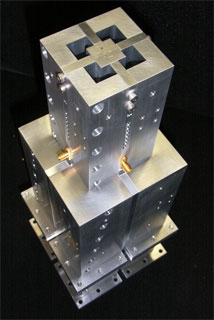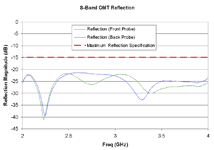
Figure 1. Fully assembled EVLA S-band OMT

Figure 2. Test results from the EVLA S-band OMT showing reflection performance exceeding specification by over 5dB across the entire receiver band.
Significant progress on the WIDAR correlator has been one of the most exciting developments for the EVLA project over the summer of 2008. All 16 equipment racks for the correlator have been installed. The correlator boards that will be installed in the racks are connected to one another by a total of 500 high speed data cables, each capable of supporting data rates of about 10 Gbps. The high speed data cables, correlator network cables, and 48V power cables were installed. The test rack, two station boards, and baseline board for a separate, prototype correlator (PTC) were also installed over the summer. After a great deal of trouble-shooting and systems integration effort, a “first fringes” observation on a single baseline was made with the PTC on August 7, 2008. The observation is described in a recent NRAO press release.
Exciting results are being obtained with the EVLA’s new wideband orthomode transducers (OMTs). The first two, full bandwidth, C-band (4-8 GHz) OMTs were installed on the array over the summer. Astronomical test observations show that the amplitude of the cross-polarization “leakage” terms of the EVLA C-band receivers are approximately 4% across the entire 4 GHz of receiver bandwidth, in comparison to the 8% leakage terms that are typically measured across 50 MHz of bandwidth on a VLA receiver. The second, and final, version of the S-band (2-4 GHz) OMT was fabricated and tested (Figure 1). Tests of the OMT show that it exceeds design specifications (Figure 2). The design of this OMT implemented the design philosophy and lessons learned from improvements to the C-band OMT.
The prototype Ka-band (26-40 GHz) receiver was shown to meet project specifications. Two Ka-band receivers have been installed on the array, and first fringes with them were recorded by the VLA correlator on August 8, 2008. Three more receivers are being assembled in the laboratory for installation on the array over the next few months.
The production of receiver feed horns continues ahead of schedule. The assembly and fiberglass lamination of all L-band (1-2 GHz) feed horns are complete. The assembly and fiberglass lamination of the S-band horns are well underway. The second S-band horn was installed on antenna 3 after antenna pattern measurements on June 9 showed that it complied with design specifications. The lamination of the third S-band horn is nearing completion. Antenna pattern measurements were made of the two, prototype Ku-band (12-18 GHz) feed horns on June 10-13 at an antenna test range on the New Mexico Tech campus. The measurements show that the horns meet design specifications.
Antennas continue to be retrofitted to the EVLA design at the rate of six antennas per year. A total of 17 antennas are now used in scientific observations and accounted for 57.8% of all antenna hours used in observations in July 2008. The mechanical overhaul of the 18th antenna is nearly complete.
Engineering samples of the 3-bit, 4 Gsps digitizer were delivered to the electronics laboratory in Socorro. Tests of these digitizers show that they perform as expected in the EVLA wideband sampler module. Additional, digitizer-specific tests are currently being made by the vendor at a testing laboratory at Wright-Patterson Air Force Base in Dayton, OH. All digitizer chips should be delivered from the vendor by October 2008. The assembly and installation of the digitizer modules will proceed slightly in advance of the printed circuit boards for the WIDAR correlator.
A preliminary version of the Science Data Model (SDM) has been incorporated into the data capture and format (DCAF) module of the EVLA monitor and control system. DCAF is the module that captures science metadata as observing scripts are executed, then reformats and stores it in a set of tables that is the SDM. These data are then written to a staging area where they are ingested into the next generation archiving system (NGAS) together with binary data from the correlator. At the present time, this is a preliminary system intended for use in on-the-sky testing of the PTC. However, it is now routinely being run on metadata from VLA observations. The version of the SDM being used is the same version currently being used at the ALMA Test Facility (ATF). A compatible version of the Binary Data Format (BDF) is also supported and has been tested with simulated data from the correlator subsystem. This combination of the SDM metadata and binary data has been successfully loaded into CASA using the same software filler that is being used at the ATF. A new NGAS server was installed at the VLA to support on-the-sky testing of the PTC. This is a smaller archive system that is intended as a staging area for science datasets.
The effort of the EVLA Science Support Systems group has been devoted to the web-based Observation Preparation Tool (OPT). The OPT needs to be able to support observatory staff in the configuration and testing of a ten-station prototype WIDAR correlator later this year and will be used to support Ka-band observing with the current VLA correlator. The OPT consists of three main components: one for configuring instrumentation, one for maintaining catalogs of target sources and calibrators, and one for assembling actual observing programs. The instrument configuration component is ready for use with EVLA antennas and the VLA correlator. The source catalog component is also ready for use, although a number of additional features will be added to it in the near future. More testing is required on the observation setup component before it can be deemed ready for use.
The AUI Visiting Committee met on April 8-9, 2008. The committee was impressed with the steady progress of bringing the EVLA to completion and noted that nearly all of its recommendations from a previous report had been addressed.